PSYC2300: Cognitive Psychology (Wk 5-7)
1/179
There's no tags or description
Looks like no tags are added yet.
Name | Mastery | Learn | Test | Matching | Spaced |
|---|
No study sessions yet.
180 Terms
Clive Wearing
Left him with anterograde amnesia (still intelligent, able to play music, and recognise his wife) after encephalitis. He shares symptoms/expression of H.M and would journal a lot (e.g. now I’m perfectly awake → sequence would repeat bc he recognised his writing but believed someone else wrote it)
3 stage process of memory (+ 4th stage)
Acquisition/Encoding = process of gaining and storing information into the LTM
Storage = information is held for later retrieval
Retrieval = process of remembering or locating information stored in LTM and moving it to active use (working memory)
*Forgetting = failure to retrieve information i.e. storage and encoding failure
Modal model of memory (Atkinson & Shiffrin)
Combines multiple models and related to information-processing approach (computer as a model for memory). Three stages = sensory → short term → long-term memory.
Limitations of modal model of memory
Sensory memory plays very small role
Model suggests that LTM and STM acts in isolation and that memory is linear (incorrect)
Assumes that only consciously processed information is in LTM
Model exaggerates role of rehearsal
STM extended beyond rehearsal i.e. involves transfer of info to and from LTM (lead to creation of working memory)
Working memory isn’t a place but a status of information
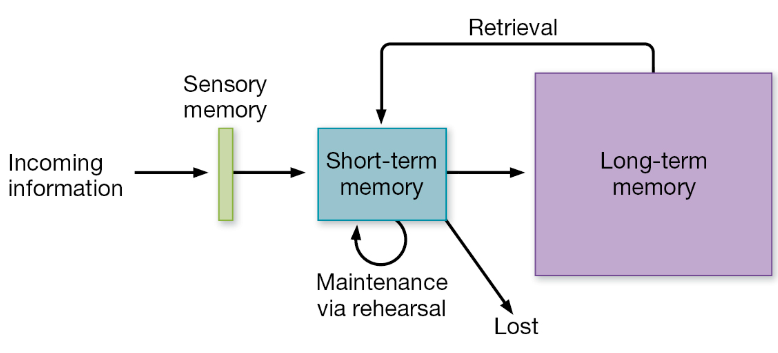
Sensory memory
Registers all information that hits receptors (sensory stimulation) and has large capacity + short duration. Important for information collection, holding information during initial processing and filing in blanks (persistence of vision and sound e.g. blinking)
Iconic memory = visual information (Sperling partial report task w/ letter grid)
Echoic memory = auditory information
Short-term memory
Limited storage of new information from sensory stores or recalled information from the LTM. Has limited capacity and duration. Information either decays (over time) or with interference (other memory tasks interfere). Distinct to working memory as it only involves the brief storage of a single component.
Working memory (Baddely)
Limited capacity system for the temporary storage and manipulation of both new and recalled information to complete higher order/complex tasks e.g. comprehension, learning, and reasoning. Distinct from short-term as it goes beyond just holding information and involves manipulation of multiple components. Individual differences in WM capacity allow manipulation of more items, more efficient allocation and suppression that leads to higher intelligence.
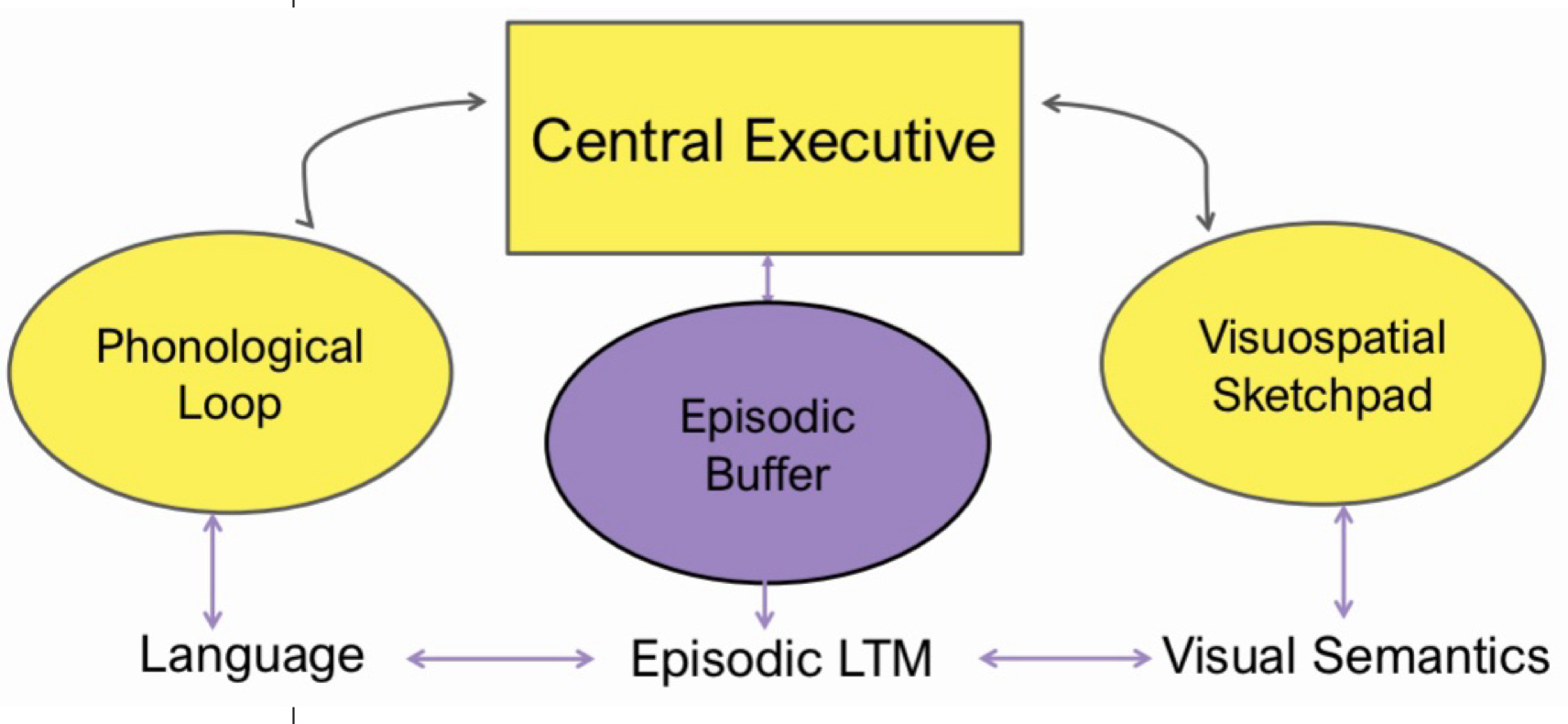
Long-term memory
Infinite capacity storage system that holds all our knowledge and memories that we aren’t currently working on. Detail varies and depends on importance or uniqueness. Shares a dynamic relationship with WM/STM and relies on encoding effectiveness for retrievability. It takes time and attention (work) to move information from STM to LTM
Free recall procedure
A method for testing participants ability to remember relevant items in any order (free) when given a broad cue
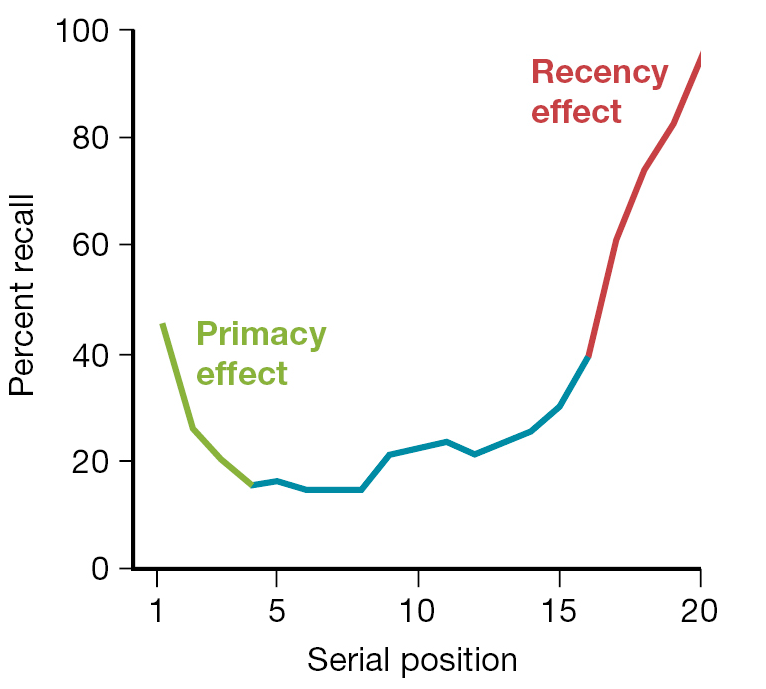
Primacy effect
Participants remember first words in the list because they have been moved to LTM. This is due to these words receiving the most amount of attention (memory rehearsal) which decreases as participants are required to divide there attention across more words. This effect is not impacted by a delayed recall counting task. Slower list presentation improves primacy effect (as LTM is limited by ease of access not capacity).
Recency effect
Participants remember last words on the list because they are still in their working memory (capacity of 5-6 words) and once the list finishes the words don’t get bumped out of working memory because there is no further input. If individuals have their recall delayed by a counting task, that task will move the words out of WM and eliminates the recency effect. Slower list presentation doesn’t improve recency effect (as WM is limited by capacity not ease of access)

Capacity of working memory
Digit span demonstrates the 7 + or - 2 rule for WM capacity. You can conceptually increase capcity through chunking = combining small units into larger meaningful units, etc. LTM can interact with STM to improve chunking e.g. Ericsson increased a students digit span to 79 through chunking (track times). You aren’t actually increasing WM capacity but providing a different memory strategy i.e. you can only retain 7 +/- 2 chunks as well.
Operation span
Measure of working memory capacity that replaced the digit-span task. Includes reading and equation span.
Phonological loop
Limited capacity storage of auditory/language related information that can be increased through articulatory rehearsal processes and subvocalisation (silent speech/inner voice). Subject to sound-like errors or the similarity effect (F & S) as inner ear processes sounds quickly. Concurrent articulation tasks that disrupt inner voice leads to articulatory suppression that disrupts phonological loop. People who are deaf have an inner hand rather than inner voice that is disrupted by hand-shape errors and hand movement tasks during memory tasks.
Visuospatial sketchpad
Creates visual imagery in mind without the presence of physical visual stimulus. Mental rottation involves the visual rotation of images through space (e.g. as 3D objects). The sketchpad is disrupted when by other visual tasks i.e. visuospatial suppresion
Rehearsal
Maintenance rehearsal = repetition without understanding (rote learning)
Elaborative rehearsal = understanding and making menaingful connections for information (more effective)
You need more than passive exposure and maintenance rehearsal (e.g. commonly seen things) for things to be in LTM, you need attention and understanding.
Level of processing
Shallow processing = only paying attention to appearance and superficial aspects of material which leads to poor memory retention.
Deep processing = paying attention to meaning and implications which leads to better memory retention as it facilitates connections and retrieval of memory later on (dynamic relationship between WM and LTM)
Memory connections
Retrieval paths that facilitate memory retrieval by allowing certain memories to trigger others e.g. linking one item to another or context dependent learning. Memory connections are more likely to be established through elaborate processing e.g. memory of words in rich sentences.
Mnemonic strategies
Techniques to improve memory accuracy and retrieval through organisation of information (not increasing storage). Acronyms, mental pictures/visualisation (e.g. spaghetti shoes), method of loci, and peg-word system (e.g. one is bun and you hang the information of that peg e.g. milk bun). These strategies involve a trade off as you don’t understand the material so you develop less connections
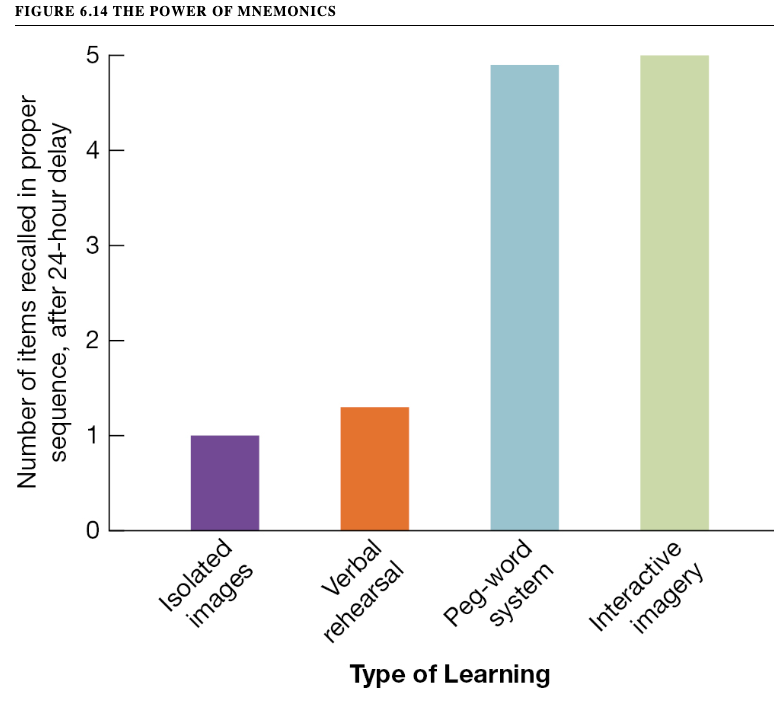
The contribution of the memoriser
Memory depends on what the individual was doing during the event i.e. what rehearsal technique and level of processing. Connections also depend on personal experiences and whether an individual has other relevant memories to connect to new information e.g. sports fans adopt new facts about sports easier.
Studying and memory
Intention to memorise and passive strategies has no effect on retention of information. Active strategies e.g. testing, teaching others, and spaced learning improve retention by creating desirable difficulty. Mnemonics are more useful after you’ve understood new material.
Mirror-drawing task
Participants have to draw a star while only seeing their reflection. Participants performance improves with attempts. Amnesiac patients performance also improves even though they don’t remember doing the task (shows that implicit/procedural memory is intact)
Two types of memory retrieval
Recall of information (broad retrieval cue e.g. what did you do last Saturday)
Recognition of information (identifying information you’ve seen before e.g. is this the man that robbed you)
Recall depends heavily on memory connections because you have to remember the information on your own whereas recognition depends on a sense of familiarity.
Context-dependent learning
Information learned in one setting is better remembered in that same setting (and vice versa). This is demonstrated in the scuba diving experiment where participants remembered information better in the matched setting e.g. studied and remembered underwater. This is caused by the environmental connections developed during learning e.g. cold triggers certain thoughts.
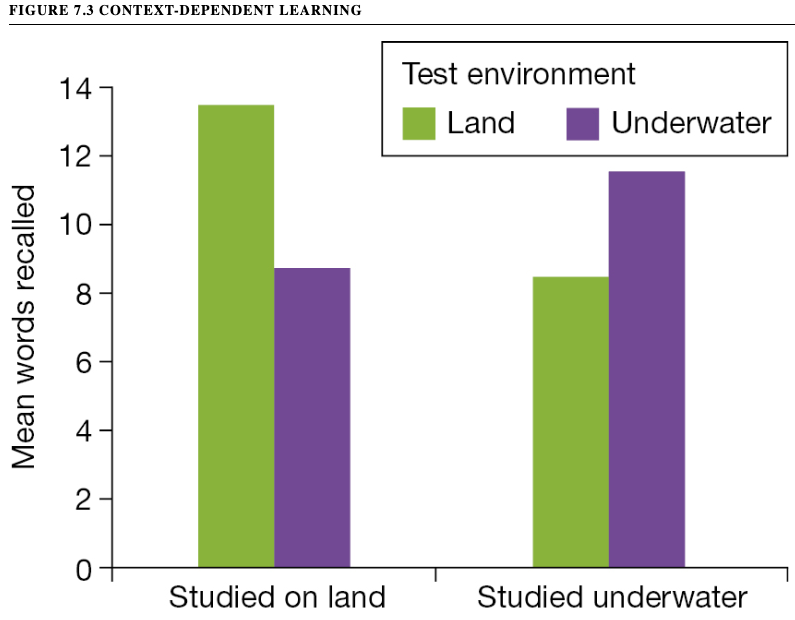
Context reinstatement
Re-creating the thoughts and feelings from when you were studying something even if you are in a different place at time of recall. This shows that it is the psychological not physical context that matters. E.g. people were asked to think about the room they had studied in and had better recall
Encoding specificity
Information is stored in memory as the content learned and the context they are learned in (memory plus this set of connections). This results in information being recognised as familiar when it appears in the similar context. Additionally, it changes the meaning of the information depending on the connections/context it is paired with e.g. piano as something heavy vs piano as musical instrument.
Associations (or associative links)
Functional connections that link nodes within a mental network or detectors within a detector network that carries activation from one node/detector to the next.
Node
Individual unit within an associative network. Using local representations, nodes represent single concepts or ideas. Using distributed representations, ideas and concepts are represented by pattern of activation across multiple nodes.
Subthreshold activation
Activation levels below the response threshold that don’t trigger a response but can accumulate and eventually reach/exceed the response threshold. This accumulation is called summation (seperate inputs combined to produce higher activation)
Spreading activation
Activation travels from one node to another via associative links which spreads throughout the network.
Lexical-decision task
A test that quickly shows participants strings of letters and asks if they are words. People perform this task by “looking up” strings in “mental dictionary”. Words that have been semantically primed will lead to faster responses as the subsequent activation of the nodes for the second word has already begun due to subthreshold activation e.g. bread → butter
Semantic priming
Activation of an idea in memory causes activation to spread to other ideas related to the first idea in meaning e.g. bread → butter
Familiarity
The subjective feeling that an individual has encountered the stimulus before and is now influenced by that previous encounter.
Source memory
A memory that enables a person to remember the episode in which they encountered the stimulus previously. Source monitoring is the process of determining the source memory.
Remember/know distinction
“Remembering” having encountered the stimulus before allows you to understand the circumstances of the encounter (hippocampus) i.e. source memory.
“Knowing” you encountered the stimulus before means you have a sense of familiarity but you can’t remember encountering the stimulus before i.e. familiarity (anterior parahippocampus).
Word-stem completion
Participants are given the start of a word and they then finish the rest. People are more likley to offer a specific word they’ve encountered recently.
Explicit memories
Involves understanding that you are remembering or recalled knowledge. Demonstrated in direct memory testing i.e. being explicitly asked to remember a previous event either through recall or recognition.
Implicit memory
Manifested as a priming effect where the current performance is affected by previous experiences. There is no conscious realisation that you are being influenced by past experiences. Demonstrated in indirect memory testing where individuals are not told their memories are being tested e.g. word-stem completion, lexical-decision task, and tachistoscopic recognition.
Illusion of truth
Familiar claims are seen as more plausible which is caused by implicit memory (so people don’t know they are being affected by familiarity)
Source confusion
A memory error where people misremember where information was learned or where a particular stimulus was last encountered. Source confusion is why multiple line-ups aren’t reliable as people recognise suspects based on familiarity from a past line up not actual crime.
Processing pathway
Sequence of nodes and connections through which activation flows when recognising or thinking about a stimulus or idea. Speed or ease of activation is refereed to as processing fluency. The use of a pathway increases its processing fluency e.g. words included in earlier lists will be recognised quicker in later lists because of increased sensitivity. People perceive processing fluency e.g. “it rings a bell” and notice discrepancies between difficult and expected difficulty.
Steps leading to judgement of familiarity and illusion of familiarity
Judgement: Exposure to stimulus → practice in perceiving → processing fluency → stimulus registered as “special” → attribution of fluency e.g. to specific prior event → familiarity
Illusion: Manipulation of stimulus presentation designed to make perceiving easier → processing fluency → stimulus registered as “special” → attribution of fluency → familiarity
Both are driven by implicit memories
Hierarchy of memory types
Explicit (conscious) → episodic and semantic memory
Implicit (unconscious and automatic) → procedural memory, priming, perceptual learning and classical conditioning
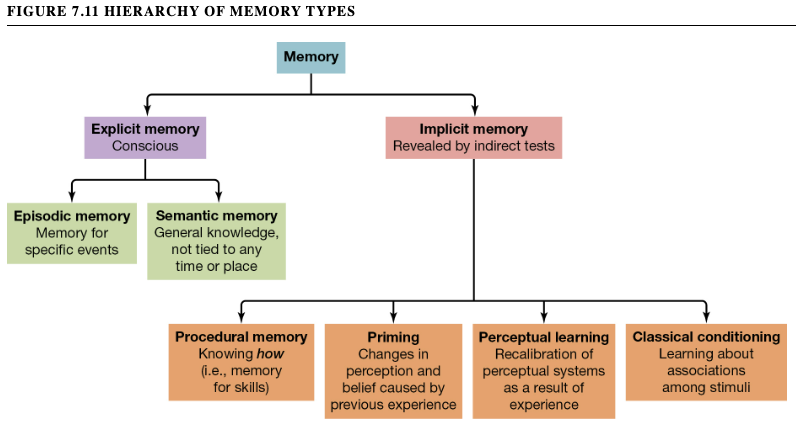
Central executive
Moves information from the LTM to the WM, coordinates the phonological loop and the visuospatial sketchpad and suppresses relevant information. Controls attentional allocation.
Relationship between semantic and episodic memory
Semantic memory can be enhanced by episodic association in autobiographical memories (experiences with semantic and episodic memory), and personal semantic memories (semantic with personal significance/context.). Semantic can influence episodic by determining what we attend to. Episodic can also be lost leaving only semantic i.e. removal of personal context like where you learned the information.
Transfer-appropriate processing
Matching task involved in encoding to the task used in retrieval e.g. meaning vs rhyming tasks. If tasks are matched there is better retrieval.
What are context effects influenced or not influenced by
Context effects occur regardless of whether the test is recall or recognition, using physical or mental context reinstatement or uses oral vs visual presentation of information.
Context effects are influenced/decreased by the presence of different experimenters at retrieval and intervals between encoding and retrieval.
Episodic and semantic memory
Episodic = self-knowledge, personal experiences and “mental time travel” (no guarantee of accuracy)
Semantic = factual information that lacks the personal context and has a massive capacity
Anterograde amnesia
Inability to retain new memories but can remember events prior to injury. For example, H.M. who was missing the anterior portion not the posterior portion of hippocampus
Retrograde amnesia
Can retain new memories but memory loss before brain injury e.g. brain tumours
Amnesiacs and memory
Amnesiacs can still form procedural memories meaning they can learn over time even if they have no memory of previously doing a task. This implies that implicit memory is intact but the explicit is impaired. However, people can have the opposite pattern where the implicit is impaired e.g. no fear response to blue light.
Double dissociation
Demonstrates that LTM and STM is seperate and that procedural, episodic and semantic is stored separately.
K.C. had damaged hippocampus → no episodic memory but semantic was intact (was able to remember information factually but lacked personal/emotional context)
Italian woman has encephalitis → no semantic memory but episodic was intact (normal autobiographical memories but no knowledge things like the meaning of words)
Korsakoff’s syndrome
Anterograde amnesia caused by damage to specific brain regions often caused by malnutrition that is common in long-term alcoholics
Truthiness
Degree to which a statement seems likely true based on intuition not evidence or logic. The illusion of truth increases truthiness. Truthiness can also be supported by internet echo chambers.
Episodic buffer
Provides extra capacity, connects WM to LTM and controls information suppresion
Memory error study examples
Dutch study: participants were asked if they remember seeing a film of a plane crash with over half saying they had seen the film (there was no film)
Doctors office: Particpants reported that the office was filled with books bc that’s what they expect to see (there were no books)
Transplant errors
Episodes begin to merge together making it difficult to know which information belongs to which event = Information encountered in one context is transplanted into another context.
Inability to seperate the actual episode from the thoughts about the episode i.e. where they apart of episode or just associated
Intrusion errors
A memory error in which a person recalls elements that were not part of the original episode. A study tested these errors by providing some participants a prologue to a story that provided meaningful context. People remembered the story better with the prologue but made four time intrusion errors based on their understanding (thoughts) of the story
The DRM Paradigm
An experimental design that elicits memory errors. Person sees/hears list related to single theme however the word of the theme is not included e.g. sleep. People are very likely to remember later that the theme word was presented
Schema
Summarise the broad pattern of what’s normal in a situation i.e. commonsense. Schemas can help fill gaps in your memory however only through plausible reconstruction. This reconstruction can sometimes cause memory/perception errors based on what normally happens → events are regularised and made more sensible. E.g. doctors office experiment
Eyewitness memory
A form of episodic memory used in the legal system that is persuasive for jurors BUT highly fallible (68% of wrongful convictions). They involve recall (witness statement) and recognition memory (lineup) and are susceptible to encoding (estimator) and retrieval (system) variables.
Eyewitness memory car crash experiment
Participants were either asked how fast the cars were going when they hit OR smashed into each other. Hit = 34 miles vs smashed = 41 miles + said they saw glass (no glass was present)
Misinformation study
Participants were asked questions containing over misinformation (E.g. “how fast was the car going when it raced by the barn”), provided other witness descriptions that contained misinformation, or were asked to make up some misinformation i.e. force the participants to make a choice. 1/3 of these studies lead to false memories.
When is misinformation more likely to be adopted
The misinformation/post event information is plausible, it supplements/adds to what person remembers (instead of contradicting) and if the participant is asked to imagine the false event instead of just hearing it. These aspects also lead to increased confidence.
Misinformation effect
Post-event information exposure between encoding and retrieval that influences memory and can cause memory impairment especially in situations where eyewitness is unsure, stressed, or the misinformation was given by an authority figure.
False memories
Developed through suggestion and constructive processes (e.g. expectations and schemas). Examples, lost in mall study, hot air balloon, punch bowl spill, alien abduction, and committing a crime.
Memory confidence
People often rely on confidence to decide whether a persons memory is accurate. However, confidence is a relatively uneven indicator of accuracy and can be influenced through confidence inflated e.g. police reinforcement.
Are schemas good or bad?
Schemas are mostly helpful and allow us to exploit the predictability of our environment, conserve cognitive resources, and guide attention to the informative/important part of a situation
Is the integration of memory connections and episodes bad
While this does contribute to memory errors it is mostly a good thing as it allows you to have all the related information about an event or person in one place.
Forgetting
Forgetting is often confused with failure in acquisition (lack of attention and encoding in the first place). “Real” forgetting involves the decay theory of forgetting (retention interval), retrieval failure, and interference.
Ebbinghaus forgetting curve
Suggests that the amount if time between initial learning and subsequent retrieval contributes to forgetting. This relationship demonstrates exponential decay i.e. forgetting is rapid at first then slows down.
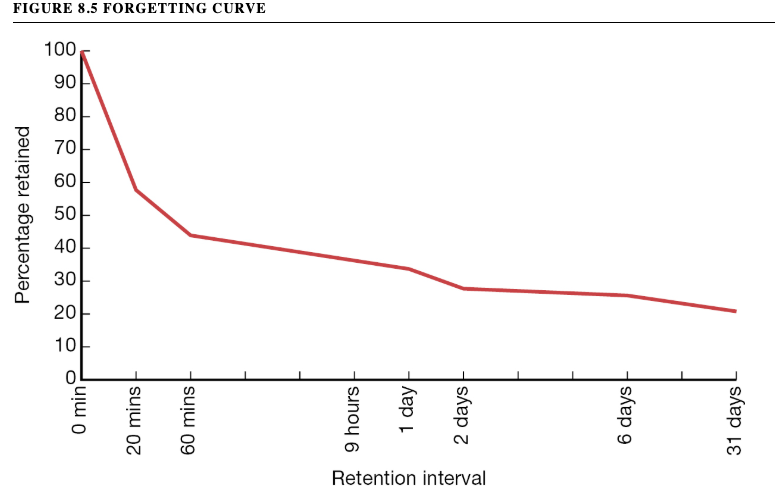
Decay theory of forgetting
Hypothesis that with the passage of time, memories may fade or erode due to relevant brain cells dying or connections weakening
Retrieval failure
“Forgotten” memory is still in long-term memory but individual cannot locate it (e.g. context dependent learning). This is supported in instances where people cannot remember something at one time and then recall it later. Some retrieval failure is partial e.g. tip of tongue phenomenon.
Interference theory
New learning interferes with older learning. New information gets interwoven with older information or new information replaces old information. Rugby team name study demonstrates that retention interval alone accounts for little forgetting and that intervening events (games) is a larger contributer.
Hypnosis
An inaccurate and unreliable method of undoing forgetting and recovering lost memories. “Recovered memories” are a mix of recollection, guesses, and inferences.
Cognitive interview
Often used in police investigations and uses context reinstatement to improve eyewitness memory by offering diverse retrieval cues without providing misinformation/suggestion.
Autobiographical memory
Long-term memories of our own life which is uniquely human. Similar to episodic but has personal significant, is complex, and contains semantic memory. These memories are often better remembered as the individual is personally involved in the event. Significant, highly emotional, and transitional events are more likely to be remembered as autobiographical.
Autobiographical memory and errors
Autobiographical memory is a mix if genuine recall and schema-based reconstruction. Additionally, your current appraisal of yourself (e.g. your identity) changes what you recall about the past e.g. study suggests that adults believe they’ve been relatively consistent in their fashion and attitudes.
Memory consolidation
The biological process through which new memories are “cemented in place,” acquiring some degree of permanence through the creation of new (or altered) neural connections. Can be enhanced through sleep and emotion. If it is interrupted later recall is impossible.
Memory consolidation and emotion
Emotion enhances consolidation as emotional events trigger amygdala → increases hippocampus activity. Emotional events are often more important → pay more attention and think about the event after more. Emotion also influences what you remember and can involve a “narrowing” of attention based on the goal produced by the emotion e.g. afraid = escape
Flashbulb memories
Vivid and high detail memories about significant and highly emotional events which have high confidence but are just as susceptible to distortion. E.g. 9/11. Memory errors are often caused by people comparing their recollection leading to co-witness contamination.
Traumatic memories
Most traumatic events are well remebered due to the emotional arousal that enhances consolidation. However, some events are not well remembered due to sleep deprivation, stress, head injuries or substance abuse
Repressed memories
A type of false memory were people recall experiences later on in life often of abuse. Linked to the satanic panic and people “uncovering” repressed memories through therapy.
Long retention intervals
Generally associated with higher forgetting but can be accurate especially in name-matching tasks and recognition tasks (e.g. psychology course information)
How does stress affect memory?
Stress hormones (e.g. cortisol) wither existing neurons (retrieval) or suppress new neuron growth (encoding). They also cause structural changes to the hippocampus resulting in decreased hippocampal volume e.g. combat stress.
Spatial memory
Navigation of environment through the development of a cognitive map (e.g. wayfinding). Hippocampus develops the cognitive environment which aids in episodic memory i.e. forming scenes and remembering locations (e.g. cab drivers have bigger hippocampi)
The Google Effect
The expectation that information will be easily available later on e.g. through google or stored files, leads to lower memory connections. The ability to find information via a google search gives the illusion of understanding but not actual understanding.
The 7 causes of memory failure
Transience (information forgotten over time), absent-mindedness (inattention), blocking (inability to access intact + encoded memory), misattribution, suggestibility, bias, and persistence (intrusion of memories you want to forget)
Photo-taking impairment
You remember less when taking photographs because you expect to be able to easily remember the event with the photo as a cue which leads to less encoding of the actual event. In a study on this it shows you have improved recall with the photo as a cue but bad recall without.
Improving memory and learning
Elaborate and associate learning, generate and test, take breaks, rest, and avoid learning illusion (familiarity doesn’t mean understanding)
Infantile amnesia
Inability to remember earliest years due to brains not being fully developed.
Reminiscence bump
Enhanced memory for adolescence and young adulthood (10-30 yrs) for people over 40 yrs dye to:
Self-image hypothesis = enhanced memory due to this period being where people form/solidify their identity
Cognitive hypothesis = periods of rapid change (i.e. adolescence) followed by stability (adulthood) lead to stronger encoding
Cultural life-script hypothesis = personal events are easier to recall when they fit into cultural life script e.g. education and getting married
Scripts
Schemas for routine events that involve a sequence of actions that usually occur during a particular experience. This can influence memory through expectations.
False memory hypothesises
Memory trace replacement hypothesis = misinformation replaces original memory
Retroactive interference = misinformation interferes with retrieval of original memory but doesn’t eliminate it
Source monitoring error = failure to distinguish source of information with the misinformation being misattributed as the original source.
Repeated events (fuzzy trace, script and source monitoring theory)
Series of experiences with the same underlying structure which cause less recall accuracy for single events. These event scan have forensic implications e.g. domestic violence.
Fuzzy trace theory = repeated experiences strengthen the “gist” t race which weakens specific memory traces
Script theory = script can aid retrieval in some instances
Source monitoring = deviations can reflect source misattribution
Person prospective memory
Memory for people we will encounter in the future which is relevant for missing and wanted person cases. Identification performance is enhanced when missing/wanted person alert contains current, multiple, and variable photographs, their name, and the appearance matches sighting appearance.
Eidetic memory
Rare form of increased sensory memory that involves vivid after images. Often confused with photographic memory and only occurs in children.
Hyperthymesia
Extraordinary and detailed memory for long-term life events which suggests a larger memory capacity. This is what researchers consider “photographic” memory. Memories for negative events don’t fade, it can be comorbid with mental conditions and people are still at risk of false memories.
Dementia
Memory problems including alzheimers and frototemporal.
Alzheimers = initial working memory loss and later long-term memory loss
Frototemporal = behaviour variant of dementia with primary progressive aphasia.
Dictionary definition theory for knowledge
Checklist definition that we use to scan definitions when identifying things and scanning common elements. E.g. Milo is a dog because a) he is an animal b) has four legs, etc. Can also include the logical rule. However, it’s difficult to develop a definition that encompasses all characteristics of dogs. Therefore we may have definitions for concrete concepts e.g. triangle but don for commonplace concepts e.g. shoe